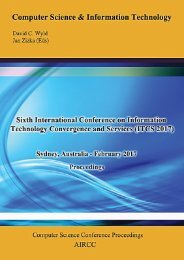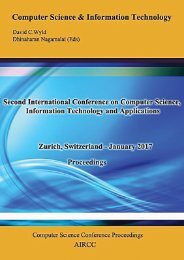CoSIT 2017
Fourth International Conference on Computer Science and Information Technology ( CoSIT 2017 ), Geneva, Switzerland - March 2017
Fourth International Conference on Computer Science and Information Technology ( CoSIT 2017 ), Geneva, Switzerland - March 2017
Create successful ePaper yourself
Turn your PDF publications into a flip-book with our unique Google optimized e-Paper software.
Computer Science & Information Technology (CS & IT) 51<br />
the perspective problem: the diminution of the size of the diver can be a problem when it must be<br />
isolated from the background.<br />
Another consequence of the flexibility requirement, is that the vide can be done also without a<br />
specific equipment, so it can have vibrations.<br />
The second need, is the requirement of a technique that can be applied also for non-expert diver,<br />
so it must be cheap. It is not possible to imagine to have a high cost equipment.<br />
Next section provides a general description of the overall procedure, then the main steps will be<br />
deeply analysed.<br />
4. VIDEO PROCESSING PROCEDURE<br />
Video processing is the technique applied here to performance assessment. While also other<br />
techniques can be applied [6], them are limited by regulatory issues in competitions and by<br />
comfort of the athlete.<br />
Video analysis is an effective technique [9] because it does not require any additional item on the<br />
divers that can influence performance (the psychological approach is really important especially<br />
during high level competitions [12]) or that are forbidden[18].<br />
It is important that the proposed technique can be applied both in training and during<br />
competitions: in this way, it is possible to compare the response of the athlete to the stress.<br />
Another important advantage of video processing is that it can be applied to official video of<br />
competitions (Olympic Games or other International Competitions). These videos can be used as<br />
benchmark in the training.<br />
Moreover, video processing results can be combined with kinematic simulations [19] to give to<br />
trainers and to athlete a complete tool in training.<br />
In the next subsection, the overall process flow chart is explained; in the following ones, the steps<br />
are described providing some example of their application.<br />
4.1. Process flow chart<br />
The overall process, described in Figure 1, is composed by five steps and it is aimed to pass from<br />
a video, acquired during training or found on the Internet, to a performance score. In this paper<br />
the first four steps are described.<br />
The first step is the image extraction by sampling correctly the video. To have a correct sampling,<br />
some parameters have to be chosen properly. Section 4.2 shows the concepts that are behind this<br />
choice.<br />
The second and the third steps are the core of the procedure of image processing: firstly, a<br />
panorama is created by mosaicking, then the barycentre of the diver is found in each image by<br />
properly apply a colour filter. These two steps are described respectively in Section 4.3 and 4.4.





